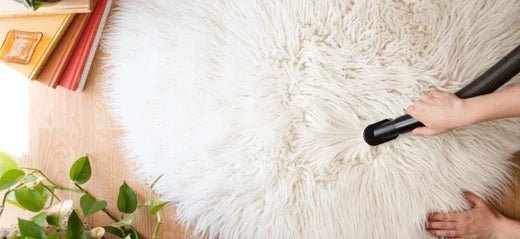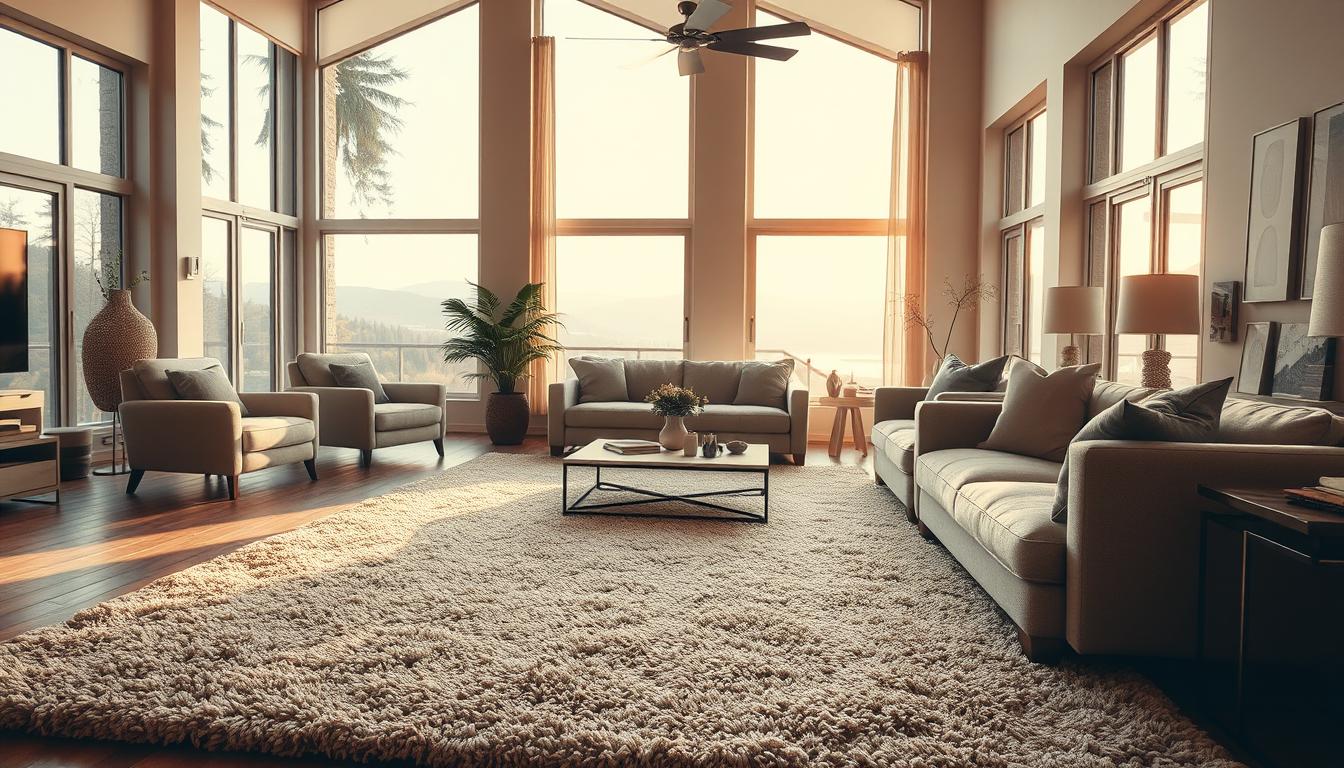
Are Acrylic Rugs Soft? 3 Comfort Facts to Know
What if your dream rug isn’t made of natural fibers? Many homeowners assume softness comes only from wool or silk, but synthetic options like acrylic are rewriting the rules. Let’s explore how these modern floor coverings balance affordability with comfort—and whether they deserve a spot in your living space.

Modern synthetic materials have evolved far beyond their scratchy predecessors. High-quality acrylic fibers now mimic wool’s plushness while offering unique advantages. The tactile experience varies based on weave density and pile height, so understanding these factors helps you choose wisely.
Durability plays a role in long-term comfort. Unlike some natural fibers that flatten over time, acrylic maintains its structure in busy areas. For households with kids or pets, this resilience means consistent underfoot support without frequent replacements. Learn how proper care, like following a targeted cleaning routine, preserves texture.
Key Takeaways
- Modern acrylic fibers rival wool’s plushness with advanced manufacturing techniques
- Weave density determines surface texture—higher loops create softer finishes
- Resists matting better than many natural materials in high-traffic zones
- Retains shape and cushioning longer due to synthetic fiber resilience
- Requires specific maintenance to preserve tactile qualities over time
Understanding Acrylic Rugs and Their Material Properties
When choosing floor coverings, material composition determines both performance and comfort. Synthetic options like acrylic have distinct advantages that natural fibers can’t match. Their unique properties make them ideal for specific spaces and lifestyles.
How Synthetics Differ From Nature’s Offerings
Petroleum-based polymers form the foundation of acrylic fibers, unlike wool or cotton. This synthetic origin allows precise control over texture and density during manufacturing. The result? Consistent quality across batches and colors that resist fading.
| Feature | Synthetic Fibers | Natural Fibers |
|---|---|---|
| Origin | Lab-created polymers | Plant/animal sources |
| Moisture Resistance | High | Variable |
| Static Control | Built-in protection | Requires treatment |
| Fading Resistance | Excellent | Moderate |
| Cost | Budget-friendly | Premium pricing |
What Defines This Modern Material
Developed in the 1940s, acrylic gained traction as a wool alternative that combats static and mildew. Its fibers mimic wool’s plushness while offering easier maintenance. For households needing stain resistance, synthetic flooring options outperform many natural counterparts.
Key traits include color retention and hypoallergenic qualities. Unlike wool blends, these carpets won’t harbor dust mites. However, avoid alkaline cleaners—they can damage the fibers’ vibrant hues over time.
Are Acrylic Rugs Soft? Debunking Common Myths
Is the plush feel of wool out of reach for budget-conscious shoppers? Modern manufacturing has closed the gap between natural and synthetic materials. Today’s options deliver comparable cushioning at a fraction of the cost.
Contrary to outdated beliefs, high-grade synthetic fibers now rival premium textiles. They achieve this through precision engineering that mimics wool’s coiled structure. The result? A surface that feels gentle against bare feet.
| Feature | Modern Acrylic | Natural Wool |
|---|---|---|
| Initial Cost | Budget-friendly | Premium pricing |
| Hypoallergenic | Yes | No |
| Texture Retention | 5-7 years | 10+ years |
| Moisture Resistance | High | Moderate |
Households with allergy sufferers gain distinct benefits from these innovations. Unlike wool variants, these textiles resist dust mites and mold growth. This makes them practical for bedrooms or play areas.
While initial comfort impresses, foot traffic impacts longevity. Flattening occurs faster than with wool counterparts. Rotating floor coverings seasonally helps distribute wear evenly.
Choosing between materials depends on priorities. Those valuing affordability and hypoallergenic traits often prefer synthetics. Fans of decades-long resilience might lean toward natural options.
Comfort Factors: Texture and Underfoot Feel
Your feet know instantly when a floor covering feels right. Three elements work together to create that perfect balance between support and cloud-like softness.
What Makes a Carpet Comfortable?
Pile height acts like a cushion layer. Thicker fibers absorb footsteps better than flat weaves. Density determines longevity—tightly packed strands resist matting in busy areas.
Backing material matters more than most realize. A quality foundation prevents slipping while adding bounce. "The best constructions use latex-coated jute for breathable support," notes a textile engineer.
Manufacturing techniques shape texture. Loop piles offer firmness, while cut piles feel luxurious. Synthetic materials mimic wool's springiness without trapping allergens. This makes them ideal for homes needing hypoallergenic solutions.
Your preference dictates the final choice. Some crave plushness for barefoot mornings. Others prioritize structured support under dining chairs. Test different options in your space before deciding.
Natural fibers like wool set high standards, but modern synthetics close the gap. Focus on density ratings and weave patterns rather than material labels alone. The right combination transforms any room into a comfort zone.
Durability and Maintenance Considerations
Floor coverings face daily challenges—from foot traffic to accidental spills. Synthetic options require strategic care to maintain their best qualities. Let’s examine how wear patterns develop and proven methods to combat them.

Pilling, Flattening, and Wear Over Time
Fiber breakdown creates tiny balls on surfaces, especially in high-use zones. This fuzziness alters texture, transforming plush textures into rough patches. Rotate pieces every 3-6 months to distribute pressure evenly.
Flattening accelerates in hallways or under furniture. Unlike natural alternatives, synthetic strands lack natural springiness. Use rug pads with cushioning to slow compression. "Thicker pads absorb impact better," advises a flooring specialist.
Practical Upkeep for Long-Lasting Beauty
Follow these steps to extend your floor covering’s lifespan:
- Vacuum weekly with a suction-only setting
- Blot spills immediately using pH-neutral cleaners
- Schedule professional deep cleaning annually
Sunlight exposure fades colors faster than wool counterparts. Position away from windows or use UV-blocking curtains. For pet owners, trim claws regularly to minimize snags.
While synthetics won’t match wool’s decades-long resilience, proper care adds 2-3 years of comfortable use. Track wear patterns and address issues early for best results.
Comparing Acrylic with Wool, Cotton, and Other Options
Selecting floor textiles involves balancing comfort against practical needs. Every material brings distinct strengths and compromises to your space. Let’s examine how popular choices stack up in daily use.
Pros and Cons of Various Rug Materials
Wool sets the benchmark for natural luxury but demands premium pricing. Its dense fibers retain shape for decades, though staining risks require protective treatments. For allergy-prone homes, wool’s allergen-trapping nature might pose issues.
Cotton delivers unmatched softness at lower costs. However, lightweight weaves fade faster and show dirt easily. These textiles work best in low-traffic bedrooms rather than busy hallways.
| Material | Advantage | Limitation |
|---|---|---|
| Silk | Luxurious feel | High maintenance |
| Jute | Eco-friendly texture | Rough underfoot |
| Polyester | Vivid colors | Flattens quickly |
| Nylon | Crush-resistant | Firm texture |
Synthetic options bridge gaps between affordability and performance. Polyester shines in vibrant hues but loses loft under furniture. Nylon withstands heavy use yet feels less plush than alternatives.
Jute and sisal offer earthy aesthetics but lack indoor comfort. Their coarse surfaces suit sunrooms more than living areas. For spaces needing both softness and resilience, mid-range synthetics often outperform plant-based choices.
Your final decision hinges on priorities. Budget-friendly synthetics mimic luxury textures, while natural fibers appeal to traditionalists. Test samples in your home to feel the difference firsthand.
Moisture Resistance and Stain Durability in Rugs
Spills happen, but your flooring shouldn’t suffer permanent damage. Modern materials excel at repelling liquids while maintaining their aesthetic appeal. This protection proves vital in kitchens, entryways, and playrooms where accidents occur frequently.

Liquid Defense Mechanisms
Synthetic fibers create a protective barrier against common household mishaps. Unlike natural textiles that soak up liquids, these materials let you wipe away coffee or juice before stains set. Their tight weave patterns prevent deep penetration, preserving vibrant colors.
High humidity won’t trigger mold growth in these textiles. This feature makes them ideal for basements or bathrooms. Polypropylene variants soil faster but respond well to targeted cleaning methods, while acrylic maintains its structure through repeated washes.
| Material | Stain Resistance | Mold Risk |
|---|---|---|
| Wool | Moderate | High |
| Cotton | Low | Medium |
| Acrylic | High | None |
| Polypropylene | Excellent | Low |
Quick cleanup preserves texture better than harsh scrubbing. Blot spills immediately using microfiber cloths—rubbing spreads pigments. For stubborn spots, follow this pH-balanced cleaning guide to avoid fiber damage.
Selecting the Right Rug for Your Home Environment
Where should plush textures live in your home? Traffic patterns dictate material choices more than aesthetics alone. Busy hallways demand rugged fibers, while cozy bedrooms welcome delicate weaves.
High-Traffic Areas vs. Low-Traffic Zones
Entryways and kitchens thrive with tightly woven synthetics. These textiles resist crushing under constant footsteps. Opt for loop-pile constructions—their interlocked strands withstand sneakers and pet claws better than cut piles.
Spaces like guest rooms or reading nooks allow luxury materials. Velvety blends work here since footfall remains minimal. Rotate floor coverings seasonally to balance wear between zones.
Always pair with a non-slip rug pad. This simple addition prevents slips and reduces fiber compression. For homes with kids, prioritize stain-resistant options in play areas—quick cleanups maintain vibrant colors.
Your lifestyle determines the ideal match. Active households benefit from synthetic durability, while low-traffic spaces can indulge in delicate textures. Test samples in actual rooms before committing.
FAQ
How does acrylic compare to wool or cotton in softness?
While wool offers natural plushness and cotton has a crisp texture, synthetic alternatives like acrylic mimic softness at a budget-friendly price. Blended fibers often balance comfort with practical upkeep, making them versatile for various rooms.
Can these textiles handle moisture without mildew?
Yes! Acrylic and polyester resist water better than natural options like jute or silk. Their synthetic structure prevents rapid absorption, reducing mildew risk in humid spaces like bathrooms or basements.
Do they flatten in busy areas over time?
Heavy foot traffic may cause slight flattening, especially in low-density weaves. Pairing with a quality pad helps maintain texture. For high-traffic zones, nylon blends often outperform others in retaining shape.
What’s the best way to clean spills on synthetic materials?
Blot spills immediately with a mild detergent solution. Avoid harsh chemicals—polyester and acrylic tolerate gentle cleaning better than delicate fibers like silk. Regular vacuuming prevents dirt buildup in textured weaves.
Are synthetics a good choice for kitchens or entryways?
Absolutely. Stain-resistant synthetics like acrylic handle spills and mud better than natural choices. Their easy-care nature suits spaces needing frequent cleaning, though avoid overly shaggy piles in dirt-prone areas.
How does durability differ between nylon and acrylic options?
Nylon outperforms acrylic in resilience, especially under heavy use. However, acrylic provides a softer underfoot feel, making it ideal for bedrooms. For active households, blended carpets offer a middle ground.
Is blending fibers better for comfort and longevity?
Combining materials like polyester-cotton or wool-nylon merges benefits. You get cotton’s breathability with polyester’s stain resistance, or wool’s warmth with nylon’s durability—ideal for balancing texture and practicality.









